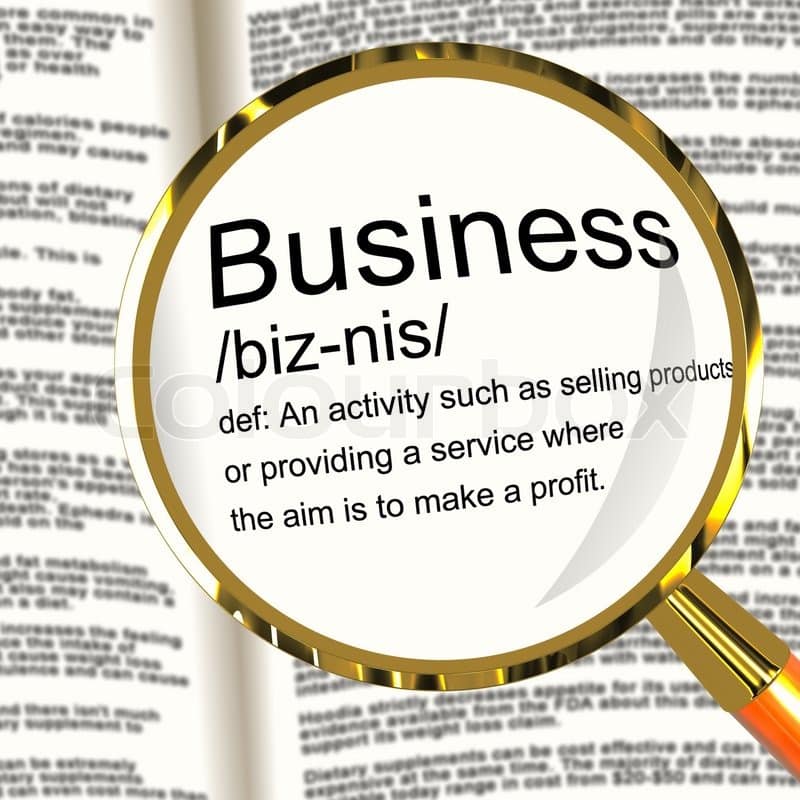Today’s business world may be summed up in one word: change. Not just any change, but rapid change. Businesses today are discovering that in order to remain profitable and competitive, they must be more responsive to client needs than ever before. This is true not only for large corporations such as Apple, Nike, and Whole Foods but also for smaller businesses such as your local hardware or grocery store. They are all affected by the quickly changing business environment. The term “business” has so many definitions and applications that we could nearly argue it applies to everything. Throughout this article, we will look at the business definition, the numerous functions, roles, features, and strategies of the business, keeping in mind that business is everywhere, just like the air we breathe!
Business Definition
A business can be defined as any organization or any other entity involved in commercial, professional, charitable, or industrial operations. It can be a for-profit or a non-profit entity, and it may or may not exist independently of the people/person running it.
We can alternatively define business as any activity that provides goods or services to customers for a profit. A business’s goods include tangible items such as cars, televisions, and soda. A service is defined as an action or work done for monetary reward. Haircuts, hotel stays, and roller-coaster rides are examples of services.
What is Business Environment?
It’s similar to our natural surroundings in some ways: it’s all around us but not always obvious. Technology, competitors (other businesses), advertising, laws, consumer needs, and money are all part of it. Companies must be able to forecast, react, and adapt to changes in various factors of the business environment, just as seasons and weather do. Those who do not comply risk becoming stranded in the rain or cold and battling to survive.
Despite the fact that the environment in which businesses operate is constantly changing, the fast pace of change creates unique difficulties and opportunities for businesses today. Consider this: in the 1950s, the average life span of a Fortune 500 corporation (the largest business we know) was more than 60 years. A Fortune 500 corporation’s life expectancy is now less than 20 years.
To get a sense of how quickly and dramatically things have changed, consider something that most Americans do on a regular basis: getting a prescription filled. You would have taken a written prescription from your doctor to your local drugstore and handed it to the pharmacist a few decades ago. While you waited for it to be filled, you could have read magazines or shopped the store for other products, such as shampoo or a greeting card. When your name was called, you most likely paid with cash or a check. All of these transactions occurred during typical business hours, which are Monday through Friday, 9 a.m. to 5 p.m.; larger pharmacies may have been open for a few hours on Saturday.
What Is the Process of Starting a Business?
Before you establish a business, be sure you understand what makes a business and any business-related activity. This includes understanding the federal, state, and local regulations that apply to your business. This understanding will assist you in avoiding penalties and fines that could cripple or end your business shortly after it begins. This knowledge will also assist you in developing a solid business plan for a successful entry into the market.
A self-employed person, a business owner, a contractor, or an entrepreneur are all terms used to describe someone who owns and operates a business. However, the terms “business owner” and “entrepreneur” are not often used interchangeably.
Most businesses in the United States register with the government in some manner. Individuals who do business under their own names may not need to register their business with the government, but they may miss out on tax breaks and credits that individuals cannot claim, such as the small business deduction.
Some freelancers, hobbyists, and side hustlers may be astonished to realize they are truly in business and must register their business income, according to how their government defines a business. Organizations like the Internal Revenue Service (IRS) provide a profit test to establish if a person or corporation is operating a claimed business.
Business activity is defined as any action carried out for profit or with the prospect of profit. Selling stuff at a flea market, from the trunk of a car, or on eBay is an example of this.
Business Definition Concept
The essential idea underpinning the business is the business concept. This concept serves as the foundation for the development of the business model, plan, vision, and mission. For example, Uber was founded on the concept of pooling taxi drivers and providing their services on demand under a single brand. This concept served as the foundation for all subsequent business strategies.
Business Goal
The business goal is what drives the business to continue operating and doing its activities in the long run. It is the cause for the business’s existence. While most people believe that profit is the primary goal of every business. Few people have proposed a new underlying goal.
According to the traditional concept, a business exists solely to generate profits by delivering goods and services to clients.
According to the modern concept, the primary goal of every business is customer happiness because this is what generates the highest profits. When the consumer is happy, the business thrives.
Types of Business
Businesses can be classed into four types, however, they are not restricted to these.
#1. Manufacturing
Manufacturing businesses are the ones who create the goods and sell them either straight to the client or through middlemen. Steel mills, plastic factories, and so on are examples of manufacturing businesses.
#2. Service
This sort of business deals with the sale of intangible commodities to customers. Services, unlike real things, cannot be stored or separated from the supplier.
Professional services, knowledge, commission-based promotions, and so forth are all provided by service firms. Salons, colleges, and consulting firms are a few examples.
#3. Merchandising
Merchandising is a middleman business strategy in which a business purchases things from a manufacturer, wholesaler, or other partner and resells them at a retail price. It is commonly referred to as a ‘buy and sell’ business since they generate money by selling their things at a higher price than their cost price.
Grocery stores, supermarkets, and distributors are examples of merchandising businesses.
#4. Hybrid
Hybrid businesses combine the qualities of two or more of the above-mentioned types of businesses. A restaurant, for example, develops its own meals (manufacturing), sells things created by other businesses (merchandising), and provides service to clients (service).
Different Types of Business Ownership
Business ownership has different forms depending on the number of owners, the owners’ accountability, representation, and goals. These are the –
#1. Sole Proprietorship
A sole proprietorship is a business that is owned and operated by a single person. It is simple to set up, use, and register. The proprietor owns all of the business’s profits and is personally liable for all obligations.
The major disadvantage of this business is that the proprietor is subject to unlimited liabilities. This means that if the business’s creditors are unable to pay them, they can go for the owner’s personal assets.
#2. Partnership
When two or more people work together to run a business, they usually form a partnership. Partnerships are classified into two types: broad and limited. A general partnership is similar to a sole proprietorship, but with more than one owner and unlimited responsibility for all owners. Some or all of the participants in a limited partnership have limited responsibility.
#3. Corporation
A corporation is a legal business distinct from the individuals who own or operate it. Shares of stock are commonly used to indicate ownership.
Owners have limited responsibility but they don’t need to be active in the day-to-day operations of the business. A group (board of directors) elected by the shareholders runs the business.
#4. Limited Liability Corporation (LLC)
A limited liability company is a type of business that combines the features of a corporation and a partnership. Because it is not incorporated, it is a partnership, whereas a corporation has limited responsibility for all partners/owners.
#5. Cooperative
A cooperative is a private business organization owned and governed by individuals for the benefit of all. These people are the members, and they profit from the cooperative’s goods and services. Because the cooperative’s principal goal is to give service to all members rather than a return on investment, all members are expected to help operate the business.
Business Size
The size of a business varies. Small businesses are those that are owned and operated by a single person. They are often managed by a single individual or a small group of people. Family restaurants, home-based businesses, clothes, book and publishing companies, dog walking businesses, and those who run trades are examples of these businesses. Profits are often low, but sufficient to sustain operations as long as the business owner(s) can operate in the black.
Mid-sized businesses often generate revenues ranging from $50 million to $1 billion. These enterprises are more established than small businesses, having a workforce ranging from 100 to 999 workers. Fair Isaac, the firm behind FICO, was named the top mid-sized employer in the United States by Forbes in 2021. In 2020, the company had over 4,000 employees and earned $1.295 billion in revenue.
Larger businesses, sometimes known as corporations, employ more than 1,000 people and generate more than $1 billion in revenue. To fund operations, they may issue company stock. Unlike smaller businesses that can operate independently of authorities, the company in this case is publicly traded and subject to specific reporting and operating requirements. Corporations include multinational enterprises such as General Electric and Walmart.
Industries in Business
A company’s business can be described by communicating the industry in which it works. Real estate, advertising, and mattress manufacturing are all examples of industries in which a business can operate.
Because the term business can refer to both day-to-day activities and the overall construction of a company, it is frequently used to refer to transactions involving an underlying product or service. ExxonMobil, for example, does business by providing oil.
Examples of Businesses
Apple
Apple is well-known around the world for its innovative goods, which include personal computers and a variety of smart devices, as well as its services, which include music and video streaming and creation services.
So, Apple founded in 1977 by Steve Jobs and Steve Wozniak, became the first publicly traded business with a market capitalization of $1 trillion. On the Nasdaq, the company’s stock is denoted by the symbol AAPL. As of September 17, 2021, intraday trade was around $145, with the company’s market capitalization reaching $2.42 trillion.
More than two million people are employed by the corporation, including 80,000 direct Apple employees. Suppliers, manufacturers, and others who are supported by the Apple store make up the remaining jobs. In 2020, the firm generated net sales of $274 billion, which were mostly driven by its product segment.
Apple’s success is based on its product line and its capacity to innovate. The corporation focuses on design and quality, both of which were important components of Jobs’ corporate vision. Apple’s products can be utilized under the same operating system, allowing users to sync them together and so saving business costs. Their capacity to design, develop, and promote new goods and services allows them to stay ahead of the competition.
Walmart
Walmart is a multinational corporation and one of the world’s largest retailers. Sam Walton launched the corporation in Arkansas in 1962. It has over 10,500 outlets in over 24 countries and employs over 2.3 million people.
The corporation went public in 1970 and trades under the ticker code WMT on the New York Stock Exchange (NYSE). Walmart stock was trading about $145 per share on September 17, 2021, with a market cap of $405.92 billion.
For the fiscal year 2021, Walmart made $559.2 billion in revenue. This figure was driven by online sales through its eCommerce section, as well as overseas sales, which were mostly reported in Mexico and Canada.
Walmart’s success can be ascribed to a variety of things, including its brand name, pricing, diversification (particularly with the inclusion of its online marketplace), effective supply chain management, and financial strength.
What Is the Best Way to Start a Business?
To start a business, you must first go through a series of processes. Conducting market research, developing a business plan, seeking capital or other forms of funding, selecting a location and business structure, selecting the right name, submitting registration paperwork, obtaining tax documents (employer and taxpayer IDs), and obtaining permits and licenses are all part of this process. It’s also a good idea to open a bank account with a financial institution to help with your day-to-day banking needs.
How Do You Get Started with an Online Business?
With a few exceptions, starting an internet business entails many of the same stages as starting a traditional business.
Before you do anything else, you must conduct market research and create a business plan. After that, choose a name and structure for your business, and then file the necessary paperwork to register your company.
Rather than looking for a real place, select a platform and create a website. Before you launch your business, you need to discover a way to create your target market, whether through traditional marketing or more innovative methods such as social media.
How Do You Create a Business Name?
Your business name should be catchy and relevant to the type of organization you plan to run, as well as something that people will gravitate toward and remember, not to mention associate with you and the items and services you plan to market. Originality is essential. Most importantly, it should not be a name that is already in use by another person. Do a business name search online to determine if it’s available or already registered.
What Is the Process of Writing a Business Plan?
Business plans are vital for running your business and can help you acquire the money you need to get started. You have the option of creating a regular or lean business plan.
A typical business plan is quite detailed and comprehensive. This comprises a synopsis of the company and how it plans to prosper. It also includes information about your market, management, products and services, marketing, and sales estimates.
Lean formats are shorter but still contain important information such as partnership details, summaries of business operations and customer relationships, cost structures, and income streams.
You can discover business plan templates online or create your own.
How Do You Apply for a Business Loan?
Loans are useful for people who do not have the capital to start their own business.
Determine the type of loan you require. You can resort to a traditional lender or an online lender. You might also look into a government-backed loan, such as those available through the Small Business Administration.
Prospective lenders want to see details on paper, regardless of which choice you choose, especially if and when you’re just starting out. Make a copy of your business plan, which should include an outline of your costs and revenue streams.
As a new business owner, make sure you have a strong credit score (because your business isn’t yet up and running), and you may be required to put down some collateral to secure the loan if you’re approved.
Define Yourself by Identifying Your Business Niche
To create a Personal Brand for yourself, you must understand this truth: Who you speak louder than what you do.
The truth is that people gravitate toward one another. There are many entrepreneurs out there with better innovations than you can or will ever have; this is not meant as an insult; it is simply a fact.
People will, however, patronize the business of your own brand, which is you! You may add additional colour, dimension, and expression to your work. They are simply enamoured with what you represent.
Here are a few easy methods to finding your niche:
#1. Identify your hobbies and interests.
Make a list of things that you are interested in and enthusiastic about. This is because there will be hurdles, and only passion, especially as a first-time entrepreneur, will keep you going. Furthermore, if you are uninterested in the subject, you may not be able to find the motivation to persevere.
Some useful hints
- What do you prefer to do in your spare time?
- What do you like to do when you’re not doing it?
- So, what are your favourite subjects to study?
- What organizations or social clubs are you a member of?
#2. Identify problems that can be solved
We will limit these to bullet points that will assist you in identifying and solving problems.
Conduct market research on your intended audience. Go to your target market and ask inquiries to find pain areas.
Look for online and offline forums. Search Quora or find forums similar to your niche, then look at the discussions going on. Similarly, what queries do people have? What are their issues?
Look up keywords. Investigate several keyword combinations using Google Trends and Google AdWords’ keyword planner. This can assist you in obtaining popular search terms relating to those pain points.
#3. Investigate your competitors
To be able to compete effectively with your competitors- those who are already in the niche you want to join, seek for;
Content of poor quality. In a niche where other business owners aren’t providing high-quality, thorough content that serves the audience, it’s simple to outrank them.
There is no paid competition. If you’ve discovered a keyword with relatively high search traffic but little competition and paid advertising, there’s a good chance you’ll find success in that market.
#4. Determine your niche’s profitability.
You should have a good sense of what niche you want to enter by now. At this stage, you should have a good notion of how much money you can make in your speciality. Aside from enthusiasm, money is another motivator.
Also, keep in mind that you do not have to start your business with your own product. You can earn commissions by collaborating with product makers, advertisers, and site owners in your industry while working on your one-of-a-kind solution.
#5. Put your idea to the test
You now have all of the information you need to select a niche, and the only thing left to do is put your idea to the test. Setting up a landing page for pre-sales of a product you’re developing is an easy way to accomplish this. You can then use paid advertising to attract traffic to this page.
How to Define a Business Strategy
It is critical to spend time thinking about your business strategy as you establish and build your business. Consider the business strategy to be your map; it will help you identify the direction of your business and what you want it to look like in the future.
You’ll have the parameters and framework to design your business or growth plan and achieve your business goals if you explicitly define the strategy.
Remember that you cannot be everything to everyone. To compete successfully, you do not need to be the market leader, but you do need to focus on your company’s capabilities to discover a method to separate from other competitors.
Formulating your Business Strategy
Once created, your business strategy establishes priorities for the firm and management team, as well as assists you in attracting and retaining the exceptional employees you require.
Individuals in your firm may focus on different priorities to complete specific tasks, but these objectives should not conflict with the company’s overarching strategic direction.
Your business strategy can be outlined in numerous paragraphs or as a series of strategic declarations. It is a synopsis of how the firm intends to achieve its objectives, meet the expectations of its consumers, and maintain a competitive advantage in the market.
Your business strategy should provide answers to the following questions:
- Why is the corporation in business?
- What is our main point of strength?
- Which customers should we continue to serve and which should we begin to serve?
- Which products/services should we discontinue, continue to offer, or begin to offer?
- Why have we chosen these strategic paths?
Answering these questions will assist you in determining your strategic priorities. After all, you can’t and shouldn’t be everything to everyone.
You don’t have to be the market leader to compete successfully, but you do need to focus on your company’s capabilities to differentiate your business from the competition and assist clients to realize the value you offer, including features and benefits.
What is a business model?
Business models outline the steps a company will take to produce and distribute goods and services while maintaining sufficient margins to stay in operation. The products or services the company will provide, the customers they will be aiming for, the distribution and promotion methods they will use, the sources of income, and the overall cost structure are all spelled out in detail. A company’s longevity and financial success are both enhanced by a solid business plan.
What is a multinational corporation?
Multinational corporations (MNCs) are large businesses with operations in several different nations. These organizations typically have a main office in one country and branches in others. Companies with a global reach can take advantage of variations in consumer demand, wage rates, and government oversight in various jurisdictions. They may also have to deal with issues like bridging cultural gaps and understanding the intricacies of the regulatory landscape.
What is a government business?
A government business is a business that is owned, operated, or controlled by a government. This can include businesses that provide essential services, such as utilities and public transportation, as well as businesses that operate in industries such as manufacturing, retail, and finance. Government businesses may be established to provide services that are not available in the private sector or to support other government objectives.
What is a nonprofit organization?
A nonprofit organization is a type of business that is formed for the purpose of serving a specific social cause or mission, rather than generating profits for owners or shareholders. Nonprofits are usually tax-exempt and rely on donations, grants, and other forms of support to fund their activities. Examples of nonprofit organizations include charities, religious organizations, and advocacy groups.
What is a small business?
Companies that are not part of a larger corporation and are run by their owners are considered small businesses. Companies with less than 500 employees are typically considered small businesses, though this definition can shift depending on the sector and the law. The creation of new products and services, as well as new positions, are often spurred by the activity of small businesses.
In conclusion
Businesses have a critical role in the economy. They offer products and services that may be purchased by both people and businesses. Businesses range in size from tiny to huge, and they operate in a wide range of industries. Business structures also differ, ranging from simple partnerships to large corporations that provide their owners with shareholder stock.
If you want to start your own business, make sure you do your homework and create a business plan. This enables you to raise the funds required to launch your business. If you keep things simple at first, you can come up with an idea that will help you grow your business and reach the same heights as Apple and Walmart.
Business Definition FAQs
What is the main purpose of the business?
A business’s principal goal is to maximize revenues for its owners or stakeholders while preserving corporate social responsibility.
Why do businesses exit?
An exit strategy allows a business owner to reduce or liquidate his ownership of a business while still making a significant profit if the business is successful. If the business fails, an exit strategy (or “exit plan”) allows the entrepreneur to reduce losses.
What is the legal definition of a business?
It is any activity or enterprise entered into for profit.
What does Business Day mean?
The word “business day” refers to Monday through Friday, excluding the legitimate public holidays mentioned in 5 U.S.C.
Related Articles
- Close Corporation: Overview, Definition, Comparisons, Pros & Cons
- Business Structures: Different Types of Business Structures Explained
- Business partnership agreement: How to structure a business partnership agreement
- CHASE BUSINESS ACCOUNT: 2023 Comprehensive Review (What You Should Know !!!)
- UNLIMITED LIABILITY EXPLAINED !!! Business Definition & All You Need
- General Partnership Definition: Taxes, Liability & Agreement







